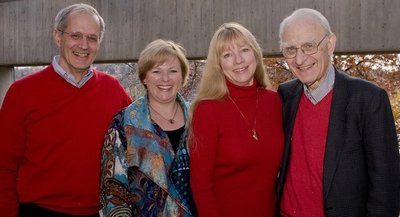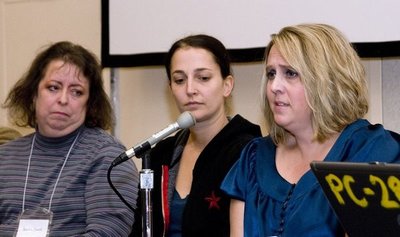November 12, 2009
Motulsky, genetics leaders, patients celebrate UW clinic’s 50 years
By Mary Guiden & Clare Hagerty
News & Community Relations
When Dr. Arno Motulsky was first recruited to the University of Washington in 1953 as a hematology instructor, he already knew that the future of medicine lay in genetics. His work in hematology—the study of blood and blood diseases, many of which are genetic — had taught him that, and continued to pique his interest in the pioneering field of medical genetics.
Four years later, with the encouragement of Dr. Robert Williams, then chair of the Department of Medicine, Motulsky founded the Division of Medical Genetics at UW in 1957. And just two years after that, in 1959, the UW Medical Genetics Clinic at UW Medical Center , among the first of its kind in the nation, opened its doors.
Today, physicians and genetic counselors at the clinic, now called the UWMC Genetic Medicine Clinic, see nearly 2,000 patients annually, providing them with diagnoses and recommendations for care and follow-up of hundreds of genetic disorders.
In celebration of 50 years of patient and family-centered care at the clinic, UW faculty and staff joined leaders in medical genetics to mark the clinic’s 50th anniversary with a gala dinner on November 5, followed by a day-long symposium and evening reception.
Motulsky, who welcomed the group at the gala dinner and presented the keynote address at the following day’s symposium, provided a historical perspective on just how far the field of human genetics has come. And his own groundbreaking work over the decades has played a key role.
In the ensuing 50 years since the clinic’s opening, Motulsky has made breakthrough advances in the field. He performed the first bone marrow transplant in an animal model and investigated the genetic basis of hyperlipidemia, an elevation of lipids in the bloodstream, in coronary heart disease. He also founded the field of pharmacogenetics, in which researchers study the role of genetic variation in response to drugs. Through the Center of Ecogenetics and Environmental Health at UW, he is involved in assessing the role of genetics in resistance and susceptibility to disease from environmental agents. And his foundational work in blood diseases, heredity-environment interactions and the genetics of color vision are recognized around the globe.
Motulsky’s renowned reputation in the field has attracted medical geneticists to UW from wide and far, helping to shape what is today recognized as the premier training program for adult genetic diseases in the nation through its strong clinical, research and education programs.
UW’s premier geneticists and counselors took center stage at the November 6 symposium, as geneticists Peter Byers, Tom Bird, Virginia Sybert, Mike Bamshad and others presented on neurogenetics, brittle bone disorders, genetic skin disorders and pediatric genetics.
Senior genetic counselor Robin Bennett shared a timeline documenting the first genetic counselor hired by the UW (1979) and discussed the relationship counselors and geneticists have with families via the clinic. Six of eight practice guidelines endorsed by the National Society of Genetic Counselors were developed at the University of Washington, said Bennett. The guidelines address not just what tests to run but also how to work with families, she said.
Patients also shared stories and praised the clinics’ geneticists, counselors and staff. Lisa Locken, who has PKU or phenylketonuria, a genetic condition in which a person lacks an enzyme and needs to be on a special diet, said she was told all of her life that she shouldn’t try to have a baby. She now has six children and came to the UW for counseling when she was pregnant with her first child. “It was a blessing for me to have this clinic in Seattle,” she said.
Darlene Miller also expressed gratitude for care provided to son Michael over the years. Her son, now 23 years old and a graduate student at Duke Divinity School, was diagnosed at an early age with Marfan syndrome, a genetic disorder of the connective tissue. “The genetics clinic would play a vital role in Michael’s care,” she said, singling out Dr. Byers for his work. “I cannot imagine making seemingly life and death decisions without this clinic,” said Miller, who fought back tears throughout the presentation.
Miller’s son participated in his first triathlon last summer, an amazing feat following surgery in 2008 to repair his aorta (due to defects related to Marfan syndrome). “Advances have been so tremendous,” Miller said at the conclusion of the session. “Now, life expectancy for our son is basically what it is for other people. Our son would not have been able to do what he did last summer without all the advances. Please keep that up.”


